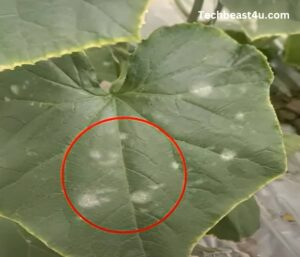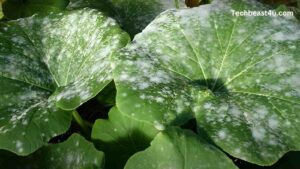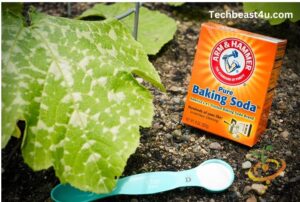Hello everyone, In this article we will know about Powdery Mildew and its important factor like it’s Introduction, Identification, Cause of Powdery Mildew, Precaution and it’s treatment.
What is Powdery Mildew
Powdery mildew is a common Fungal disease affecting a wide range of plants. It is caused by Ascomycetes belonging to the order Erysiphales. It is one of the easier plant disease to identify. Infected plants have white powdery spots on the leaves and stems but symptoms can vary depending on the plant species.

Also read: A comprehensive guide for thiamethoxam insecticide in 2024
Wind can spread the mildew spore from plant to plant. It is most commonly seen on the upper sides of leaves, but can also affect the bottom side of the leaves. It can also affect many types of plants, including fruits, vegetables, grains, grasses, and vines. The fungus forms feeding structures called haustoria to absorb nutrients from the host plant.
How to identify powdery mildew disease

- It is white or grayish powdery patches on leaves, stems and buds. These patches can appear like flour are sprinkled over the plant.
- Affected leaves become deformed or curled .
- Plant growth reduced on mildew affect.
- Leaves turn into yellow color and falling down premature leaf.
- Early detection on older leaves can help to manage the spread.
- The areas around the Powdery spots may turn into yellow color and premature leave may drop off early.
- Infected plants may stop growth and poor flowering or fruiting.
Causes of Powdery Mildew
- Powdery mildew is caused by various species of fungi from the order Erysiphales.
- The primary factors including to its development is Environmental condition, Poor air circulation, Plant stress, Shade and Fungal spores.
- Powdery Mildew thrives in warm, dry environment with low humidity. Dense plantings reduce air circulation and creating a microenvironment for mildew development.
- Stressed plant due to drought and nutrient deficiency are more susceptible to fungal infections.
Plants in shaded areas have high humidity level, that encourage the growth of powdery Mildew. This disease is spread by airborne spores. - The fungi typically thrives in temperature ranging from 15°C to 21° C . They are less active in extremely hot and cold temperatures. It require enough moisture to germinate and infect .
Precautions of Powdery Mildew
To prevent and manage powdery mildew follow these precautions like
- Choose registrant varieties, Improve Air circulation, maintain humidity level, Water properly, Regular Inspection, Use fungicides, Rotate crops, Maintain plant health etc.
- Select resistance plant varieties for Powdery Mildew . Avoid overcrowding or dense planting . Space plants well enough to ensure good air flow .
- As we know , mildew prefer dry conditions. Avoid high humidity around plants , especially in shaded areas .
- Water early in the day to allow leaves to dry before evening . Regular check plants for early sign of powdery mildew because early detection can help in managing the disease before it spreads .
- If Mildew is detected , use fungicides as directed . Always follow given instructions for safety and effectiveness.
- Avoid planting the same crops in the same location year after year . Practice crop rotation to minimize fungal spores in the soil .
- We should keep in mind that , plant receive proper nutrients and avoid access nitrogen because it may increase possible diseases. Healthy plants are better able to resist infections.
Treatment of Powdery Mildew

- In treatment of Powdery Mildew involve cultural control, Organic practices and chemical treatments.
Remove infected plant parts to reduce the source of fungal spores. - Space plants appropriately and avoid dense foliage to enhance air flow and also avoid overhead watering.
- In organic treatment use Neem oil, Baking soda, Milk solution, Sulfur etc. Neem oil acts as both a fungicides and an insecticides.
- Mix 1 tablespoon of baking soda with 1 gallon of water and a small amount of liquid soap then spray this solution on affected plant to help control powdery mildew. Milk have antifungal properties that may help manage Mildew.
- These are absorbed by the plant and can provide long – lasting control.
Healthy plants are more resistant to diseases. Need regular pruning of plants to remove infected leaves and stems. This reduces fungal spores and help to improve air circulation.
Conclusion of Powdery Mildew Disease
Powdery Mildew is a common fungal disease affecting a wide range of plants, characterized by white Powdery spots on leaves, stems and buds . It thrives in warm, dry conditions with poor air circulation. For the management of Powdery Mildew involves Cultural controls, Organic treatment and chemical treatments, Spacing, proper watering, humidity, temperature, plant selection, crop rotation, early inspection, use of fungicides as well as insecticides.
Frequent Asked Questions
1. What is the main cause of Powdery Mildew?
Powdery Mildew is basically caused by the fungi belonging to the order Erysiphales. These fungi thrives in warm, dry environment and are spread by airborne spores. Factors affect powdery mildew is high humidity, poor air circulation and overcrowded plants.
2. What is the best treatment for Powdery Mildew?
The best treatment for Powdery Mildew often involves a cultural contols like Improve Air circulation , Avoid overhead watering , Remove affect plant parts. Chemical treatments like use of fungicides and insecticides and Natural remedies like use of Neem oil , milk solution and Baking soda solutions.
3. Which fungicide is best for the Powdery Mildew?
For Powdery Mildew several fungicides are used which is given below:-
Sulfur based fungicides, Potassium Bicarbonate , Neem oil etc. Sulfur based fungicide is effective against powdery mildew. Potassium Bicarbonate is natural and effective that help to neutralize the mildew’s environment. Neem oil act as both fungicide and an insecticide helping to control Mildew and other pests.
4. What temperature kills powdery mildew?
It typically thrives in temperature between 15°C to 27°C. Temperature above 29°C can inhibit its growth and temperature above 32°C can help to kill the fungus.
5. What are the first sign of powdery mildew?
The first signs of powdery Mildew are White or grayish powdery spots on the upper surface of the leaves, affected leaves may become curled or twisted, affected areas may turn into yellow called yellowing of leaves and also reduced plant growth or poor flowering and fruiting.

Pingback: Downy Mildew: Identification, Cause, Precaution And Treatment -
Pingback: Rust Disease: Identification, Cause, Precaution And Treatment -